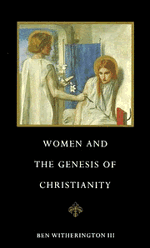Book contents
- Frontmatter
- Contents
- Acknowledgements
- Preface
- PART I WOMEN IN FIRST CENTURY CULTURES
- PART II JESUS AND WOMEN
- PART III PAUL AND WOMEN
- 8 Women and the physical family
- 9 Paul and the household tables
- 10 Women and the family of faith
- 11 Paul and his female co-workers
- 12 The Pastoral Epistles
- PART IV WOMEN AND THE EVANGELISTS
- Conclusions
- Notes
- Select bibliography
- Index
9 - Paul and the household tables
Published online by Cambridge University Press: 10 January 2011
- Frontmatter
- Contents
- Acknowledgements
- Preface
- PART I WOMEN IN FIRST CENTURY CULTURES
- PART II JESUS AND WOMEN
- PART III PAUL AND WOMEN
- 8 Women and the physical family
- 9 Paul and the household tables
- 10 Women and the family of faith
- 11 Paul and his female co-workers
- 12 The Pastoral Epistles
- PART IV WOMEN AND THE EVANGELISTS
- Conclusions
- Notes
- Select bibliography
- Index
Summary
Introduction
One of the most fascinating areas of New Testament studies is the examination of the household tables, codes which outlined the relationships and responsibilities between people in a household (Col. 3.18 – 4.1, Eph. 5.22 – 6.9, 1 Tim. 2.8 – 15, 6.1 – 2, Titus 2.1 – 10, and 1 Pet. 2.18 – 3.7). There are several prominent schools of thought about the origins, nature, and purpose of these codes. On the one hand, it is claimed that we have here material primarily Hellenistic in origin and not situation specific in nature (M. Dibelius, K. Weidinger). On the other hand, it is contended that this material owes its origins and substance primarily to Hellenistic Judaism and/or the Old Testament (E. Schweizer, E. Lohse, J. E. Crouch, W. Lillie). Yet a third opinion is that these tables are fundamentally Christian in origin (K. H. Rengstorf), and that their ethical ideas may go back to Jesus' teaching and example (D. Schroeder). Needless to say, there is no consensus on these matters, nor is there likely to be in the near future.
Can we talk about a pre-New Testament household table that could be the oral source or even the literary predecessor of the New Testament tables? After a careful study I have come to the conclusion that while discussion of household management was a standing topic in antiquity, both before and during the New Testament era, I can find no direct evidence of a household table and certainly nothing like what we find in the New Testament with reciprocal pairs that are commanded directly.
- Type
- Chapter
- Information
- Women and the Genesis of Christianity , pp. 147 - 162Publisher: Cambridge University PressPrint publication year: 1990
- 1
- Cited by

